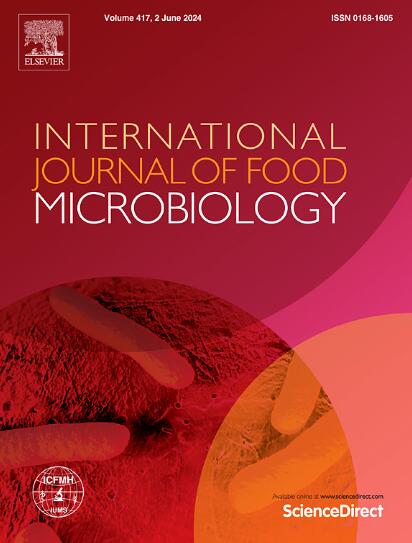Cold-active β-galactosidase from Weissella confusa SW1 for the preparation of low-lactose milk
IF 5
1区 农林科学
Q1 FOOD SCIENCE & TECHNOLOGY
International journal of food microbiology
Pub Date : 2025-02-02
DOI:10.1016/j.ijfoodmicro.2024.111003
引用次数: 0
Abstract
β-Galactosidases can be used to degrade lactose in milk to prepare lactose-free milk, which is sweeter than ordinary milk and suitable for people with lactose intolerance. The β-galactosidase gene (WcGal2809) was cloned from Weissella confusa SW1 and successfully expressed in Escherichia coli BL21(DE3). The active WcGal2809 was identified to be a heterodimer composed of two distinct proteins LacL (72.4 kDa) and LacM (33.2 kDa), and it belonged to glycoside hydrolase family 2. The purified WcGal2809 showed the maximum activity at 25 °C and pH 7.0 for o-nitrophenyl-β-D-galactopyranoside (oNPG). WcGal2809 was strongly activated by Mn2+, Mg2+, and Fe2+, and significantly inhibited by Zn2+, Cu2+, and Ni+. The activity of WcGal2809 decreased quickly after incubation at 40 °C or higher temperature, suggesting it was a cold-adapted enzyme. Additionally, 6 U of WcGal2809 could hydrolyze 85.23 % of the lactose in 1 mL of milk at 25 °C after incubation for 48 h, while 2 U of WcGal2809 could hydrolyze 74.40 % of the lactose in 1 mL of milk at 25 °C after incubation for 7 d. Taken together, WcGal2809 is a promising industrial biocatalyst for efficiently hydrolyzing lactose in milk at room temperature during milk storage or transportation.
产自白尾草SW1的冷活性β-半乳糖苷酶用于制备低乳糖乳。
利用β-半乳糖苷酶可以降解牛奶中的乳糖,制备出比普通牛奶更甜的无乳糖牛奶,适合乳糖不耐症患者饮用。从confusa Weissella SW1中克隆到β-半乳糖苷酶基因(WcGal2809),并在大肠杆菌BL21(DE3)中成功表达。活性蛋白WcGal2809是由LacL (72.4 kDa)和LacM (33.2 kDa)组成的异源二聚体,属于糖苷水解酶家族2。纯化后的WcGal2809在25℃和pH 7.0条件下对邻硝基苯基-β- d -半乳糖苷(oNPG)的活性最大。WcGal2809被Mn2+、Mg2+和Fe2+强烈激活,被Zn2+、Cu2+和Ni+显著抑制。WcGal2809在40°C或更高温度下孵育后活性迅速下降,表明它是一种冷适应酶。另外,WcGal2809的6u在25℃条件下培养48 h后,能水解1 mL牛奶中85.23%的乳糖,而WcGal2809的2u在25℃条件下培养7 d后,能水解1 mL牛奶中74.40%的乳糖。总之,WcGal2809是一种很有前途的工业生物催化剂,可在牛奶储存或运输过程中,在室温条件下高效水解牛奶中的乳糖。
本文章由计算机程序翻译,如有差异,请以英文原文为准。
求助全文
约1分钟内获得全文
求助全文
来源期刊
CiteScore
10.40
自引率
5.60%
发文量
322
审稿时长
65 days
期刊介绍:
The International Journal of Food Microbiology publishes papers dealing with all aspects of food microbiology. Articles must present information that is novel, has high impact and interest, and is of high scientific quality. They should provide scientific or technological advancement in the specific field of interest of the journal and enhance its strong international reputation. Preliminary or confirmatory results as well as contributions not strictly related to food microbiology will not be considered for publication.

 求助内容:
求助内容: 应助结果提醒方式:
应助结果提醒方式:


